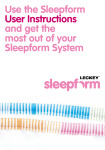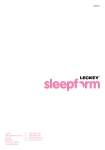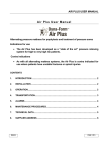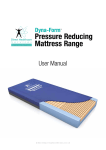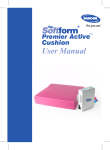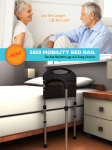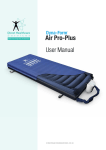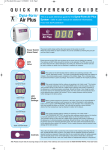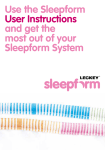Download User Manual - Direct Healthcare
Transcript
Dyna-Form Air Alternating Pressure Relief Overlay System 1 Contents Introduction 3 General Warnings 4 Control Unit 10 Unpacking / Setting Up 5 Air Filter 10 Setting Up 6 Mattress Cover 11 Connect Mattress 6 Washing 11 Power Connection 6 Inner Mattress Components 11 Switch On 6 Trouble Shooting 12 7 User Service 13 Preparation of the bed 7 Service 13 Correct Comfort Setting 7 Warranty 13 Transport 9 System Storage 14 CPR/Reanimation 9 Technical Data 14 Supplier Address 15 Operation 2 Cleaning 10 Introduction Congratulations to purchasing the Dyna- pressure ulcers (bed sores caused by Enjoy the ease of use and peace of mind Form Air Alternating pressure relief loss of skin blood flow). with special features like the comfort overlay system. The Dyna-Form Air Alternating pressure control and rapid CPR deflation. This high quality medical product if relief overlay system is suitable for the The small, lightweight control unit is quiet installed and cared for will provide many prevention of pressure ulcers and the and robust. years of trouble free service, and treatment of pressure ulcers up to grade The Dyna-Form Air Alternating pressure outstanding clinical performance. 2. relief overlay system meets the comfort * Please take time to read the contents The Dyna-Form Air Alternating pressure and clinical requirements of all your of this manual before installing the system. relief overlay system is quiet, patients up to 150 kg (300 lbs). * Please keep the manual in a safe comfortable and simple enough for single caregiver installation. place for future reference. The Dyna-Form Air Alternating pressure relief overlay system is positioned on top of an existing mattress. The alternating pressure relief action has been demonstrated to reduce the risk of 3 General Warnings General Warnings These are general warnings that apply at * Suffocation risk: The cover is not air * Risk of electrical shock: Do not spill any time. Specific warnings will be given permeable. Assure that the patient can use the product safely. food or liquids onto the control unit. If spillage occurs disconnect from the mains and allow at least 24 h drying time before re-use. within the specific operating procedures within this manual. * Risk of explosion: Do not use in the presence of flammable gases such as anaesthetic agents. In line with MDA/2013/073 the manufacturer warns against the dangers of smoking in bed. * Risk of injury: Do not use in the presence of smoking materials or open flames. Air circulation in the mattress will assist combustion. * Risk of electrical shock: Only to be opened by suitably qualified service personnel. * Never drop or insert any objects onto or into the product. * Risk of injury: The manufacturer recommends the use of bedside rails whilst the product is used on a bed. Please refer to your local procedures * To disconnect the device from mains pull the mains plug out of the mains socket. * Risk of electrical shock: Never partially or fully submerge electrical equipment in fluids. * Risk of electrical shock: Always plug the equipment into a properly grounded mains socket. 4 * Risk of damage: Keep the complete system away from radiators or other heat sources. Unpacking Setting Up Place the mattress overlay in its cover There are three components to the onto the existing mattress and attach the system, the control unit, the mattress 6 fixing straps to the bed frame. The and the user manual. strap with the letters CPR must be positioned towards the head end of the bed. Check that the CPR valve is closed (see section CPR). On the back of the control unit are integrated hooks that swing out and suit most bed frames. Hang the control unit onto the outside of the foot board of the bed. Alternatively don’t swing out the hooks to place the unit onto hard floor. Tidy the pipe but don’t kink. * Risk of damage or injury: Do not fit the straps to any part of the bed-frame but only to the mattress. 5 * Risk of injury: Make sure the pipes are not kinked. Don’t place unit on thick carpet. Both can obstruct the air flow. Setting Up Connect Mattress Power Connection Switch On Plug the air connectors of the mattress Connect the unit to a power supply that Toggle the on/off button once. The into the appropriate connectors on the matches the voltage and frequency on switch illuminates green; the system control unit. Make sure you push the the rating label on the back of the unit. switches on and starts to inflate the connector all the way, listen for a click. * Risk of injury: Store the mains cable in a secure manner underneath the bed to avoid tripping over. mattress. Until the mattress has reached pressure the ‘low pressure’ indicator will illuminate. The inflation can take up to 30 minutes depending how flat the mattress was beforehand. 6 Operation * Risk of injury: Follow now the setting up procedure, see ‘Correct Comfort Setting’ section. Preparation of the bed The mattress will be inflated when the Correct Comfort Setting low pressure indicator switches off and The mattress pressure can be altered by the normal pressure indicator comes on. turning the knob on the front of the Once the mattress is inflated, place a control unit. Number 1 represents the loose bed sheet on the mattress. The lowest pressure (softer mattress) and bed is now ready and the patient can be number 7 the highest pressure (harder placed on the mattress. mattress). The correct setting will depend on the patient’s weight and if the backrest is raised. 7 Operation Comfort Setting Example: If the patient weighs 75 kg (approx. 11 stone) then the comfort setting shall be set between a minimum of 4 ½ and a maximum of 5 ¾. Seating For seating raise the pressure by one. If the patient weighs 75 kg (approx. 11 stone) then the comfort setting shall be set between a minimum of 5 ½ and a maximum of 6 ¾. Return to lower settings when the patient lies down again. * Risk of injury: If the control unit is set higher or lower than suggested in this 8 Transport manual pressure relief might be compromised. CPR / Reanimation disconnect both air pipes from the control unit and connect quickly together. The pressure equalises between the cells leaving a soft surface for the patient to lie on. However, it is necessary to reinstate alternation as soon as possible as even an equalised mattress will not provide full pressure relief. Transport * Risk of injury: If the product is left disconnected from mains pressure relief is compromised. Connect to mains and switch on as soon as possible. CPR / Reanimation If a firm surface is needed in case of a cardiac arrest it is necessary to let the air out of the mattress quickly. Pull the tag When it is necessary to disconnect the marked ‘CPR’ firmly down so that you mains cable from the mains supply (for can feel two seals coming of the internal example for moving the patient’s bed) mattress pipes the alternation might just stop when one cell is inflated and one cell is deflated. Over a period of time this can be damaging to the patient. Therefore 9 CPR / Reanimation Cleaning * Risk of injury: Always disconnect the control unit from the mains before attempting to carry out any cleaning or maintenance. Do not submerge the unit in fluids. After resuscitation open the zip of the mattress cover until you have access to the CPR tag. Close the two valves again assuring that they are fully pushed home. The product can now be used again. Follow the appropriate steps in the section ‘setting up’. * Risk of injury: Failure to close the valves properly will eliminate pressure relief. * Risk of damage: Do not use phenol or hyper carbonate based solutions for cleaning the product. Do not heat or steam autoclave the control unit. Do not use abrasive compounds or pads. * Risk of cross infection: Take all necessary steps to avoid cross infection, if necessary talk to a hygiene specialist. Control Unit Wipe off dust with a dry cloth. If necessary clean the exterior of the housing with a disinfectant solution or a Air Filter mild detergent with a damp (not moist!) Check the air filter on the rear of the unit cloth. Alternatively wipe down with a on a regular basis for built up of dust or sodium hypochlorite solution (not more dirt. If built up is visible turn off the than 10’000 parts per million available control unit and disconnect from the chlorine). mains. 10 Cleaning * Risk of damage: Do not use phenol based solutions. The mattress cover and pipe sleeve can be washed at a maximum of 60°C, then dry covers thoroughly. Do not tumble dry Remove and discard the old air filter by the covers. Do not iron the covers. unscrewing the lid. Replace with a new air filter and screw the lid back on. Assembly of the mattress is in reverse Mattress Cover Washing The mattress cover (and pipe cover) can Removal of the mattress cover: Pull back be liberally swabbed with hot water at the grey sleeve of the mattress cover 60°C containing a mild detergent, then that covers the air pipes (see picture). dry thoroughly. Then open the button of the pipe sleeve of the mattress can be wiped down as Alternatively the cover can be liberally and pull it off over the air connectors. described under the section mattress swabbed with a sodium hypochlorite Then open the mattress zip and take the cover. Do not wash the inner solution (not more than 10’000 parts per mattress out of the cover pulling the air components of the mattress. million available chlorine). Then dry pipes through the grey sleeve. order of the previously described steps. thoroughly. 11 Inner Mattress Components When necessary the inner components Trouble Shooting Fault Occurring Ensure That Possible Solution (Next stage) Still not working No indication that the product is on The mains plug is plugged in and the unit is switched on Try another mains socket Return the system to the nearest service station Fuses in the unit are not blown Replace fuses (see section fuses) The fuse in the plug is not blown Replace with the correct fuse (3A) The hoses are connected and not kinked Disconnect the hoses and re-connect them There are no leaks in the mattress Replace the damaged mattress components with correct spares The connectors are connected correctly Disconnect the hoses and re-connect them There are no leaks in the mattress Replace the damaged mattress components with correct spares The pressure is in the correct range for the patient Turn the pressure up or down within the correct pressure range (see section ‘correct comfort setting’ The system doesn’t alternate The hoses are connected and not kinked Disconnect the hoses and re-connect them removing any kinks Return the system to the nearest service station The pump is noisy The pump is not resting on a solid surface Re-position the pump either on floor or hang on suitable surface Return the system to the nearest service station Low pressure indicator stays on The pump is on but not inflating 12 Return the system to the nearest service station Return the system to the nearest service station User Service Warranty Service The product has a warranty of 24 months for manufacturing errors. You need to contact the supplier at the earliest opportunity. The supplier will replace or repair the product free of charge depending on the failure that occurred. Fuses Service / Maintenance Warranty is accepted if there is no user The fuses are situated underneath the * Risk of injury: Only authorised technical personnel should open this equipment. schedule has been followed as advised control unit. A suitable screwdriver is needed to change the fuses. To access the fuse unscrew the fuse holder cap anti clockwise. Exchange the fuse and screw carefully back clockwise. The product uses 1A, slow blow (T), 250V fuses. When arranging a service or a repair please quote the serial number that can be found on the label underneath the pump or in the mattress cover. 13 damage and if a regular maintenance by the supplier. If the supplier does not accept warranty then the supplier will quote for the required repair work or replacement. System Storage Technical Data Cycle Time Supply Voltage Power Rating Fuse Rating Dimensions To store the system release all air by pulling the CPR tag (see section CPR). Once empty do not forget to connect the valves again. Disconnect the air connectors from the control unit and roll 10 minutes 230 Volts / 50 Hz Electrical Safety EMC Electrical classification Flammability Rating Mode of operation Symbols 1A (T) Slow Blow (x 2) Mattress Inflated Control Unit X W: 120mm (180mm incl. connectors) Y H: 97mm Z L: 270mm Conforms to BSEN 60601-1-1 Conforms to BSEN 60601-1-2 Class 2 BF with functional earth Complies with BS7175 Ignition Source 0, 1 and 5 Continuous the mattress up, starting from the head System alternating end rolling towards the foot end. Place Date of manufacturing the connector tubes in the roll. Use the straps provided to tighten the mattress. O I System off System on Read the user manual Type BF Class 2 This product is CE marked in accordance with EC Directive on Medical Device (93/42/EEC). 14 Supplier Address Direct Healthcare Services Limited Unit 8, Withey Court Western Industrial Estate CF83 1BF United Kingdom Tel: 0845 459 9831 Fax: 0845 459 9832 Dyna-Form is a registered trade mark of Direct Healthcare Ltd. Products undergo continuous further development. We therefore reserve the right to change the specifications of the product and the warranty conditions without prior notice. Issue 1, 16/04/10 Manufactured in the UK 15
















